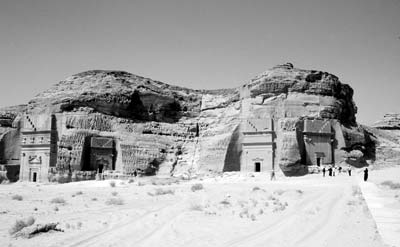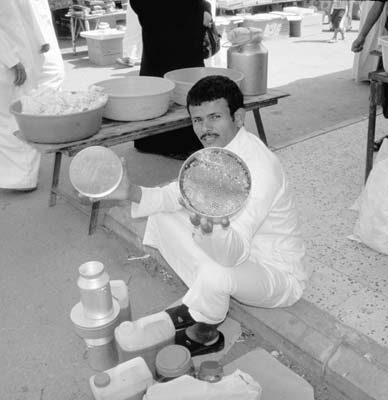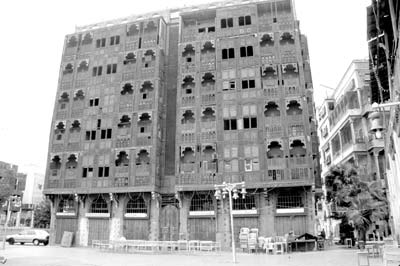The Kingdom of Saudi Arabia
Along with a group of nine other adventurers, I went on a tour of a country that few travelers have ever been allowed to visit, the Kingdom of Saudi Arabia (KSA), March 24-April 8, 2007.
We went with Bestway Tours & Safaris (Ste. 206, 8678 Greenall Ave., Burnaby, B.C., Canada V5J 3M6; 800/663-0844 or 604/264-7378, www.bestway.com), which arranged the visas for us. For this tour, I paid about $4,500 from New York.
When King Abdullah (Abdullah bin Abdul Aziz Al Said) of the KSA met with President Bush at Crawford, Texas, in April 2005, he agreed to allow restricted tourism to his country by Americans. Since tourist visas for Americans still did not exist, we were allowed entry to the country under work visas proclaiming us to be consultants working for Saudi Arabian Airlines, owned by King Abdullah.
The flight from JFK Airport to Jeddah on Saudi took approximately 12 hours. The plane has an area exclusively for prayer, complete with prayer rugs — never a bad thing on a flight.
Once there, our group required special handling. Public transportation does not exist in the Kingdom; everyone owns cars and there is no tourist infrastructure. Our group was met by two men who had taken turns driving a large bus over 2,000 miles from Damascus, Syria. While they drove ahead to meet us, we were treated to a very pleasant half-day train ride across the desert between Riyadh and Hofuf.
On the bus, we were transported more than 1,000 miles across the country, from the west coast (Red Sea) to the east coast (Gulf of Oman), with only one break. Throughout most of our touring, our bus was preceded and followed by a 2-car police escort. The front vehicle often had its lights flashing as it led us on our strictly controlled route.
At the end of our trip, the drivers delivered us to Bahrain and immediately began their drive of 2,000-plus miles back to Syria.
THE PEOPLE — The population of the Kingdom is 23 million. Of those, 16 million are Saudi. The remaining seven million comprise the workforce of KSA, expatriates from other Muslim countries. The oil-rich locals generally do not work, though the government is supposedly trying to implement Saudization in the workforce, with somewhat limited success.
The Saudi men are easily recognized by their attire: thobes (or thawbs, pure-white garments) and ghutras (red-and-white head scarves) topped with egals (black rings).
Saudi women all obey the strict Muslim dress code, wearing abayas (black robe-like garments covering them from neck to ankles and wrists), with black scarves covering their hair. A significant number each also covers their faces, some completely and the rest showing only their eyes. The women in our group also were required to wear the abayas and head scarves when outside of our hotels.
Saudi women are definitely second-class citizens. They are not allowed to vote or to drive cars and are restricted from entering many public places. When allowed in public buildings such as banks and pharmacies, they have separate entrances that channel them to their own area for conducting business.
OIL — First discovered in the 1930s, oil has transformed the Kingdom. Formerly it was primarily a nomadic nation, and now most of its citizens are wealthy and enjoy a very high standard of living. Very few Saudis work. Their housing is provided by the government; all education and health care is free to them, and they are not taxed.
Saudis spend some of their wealth in upscale shopping malls. Clusters of their Mercedes-Benz, Ferrari and BMW automobiles, with the occasional Lamborghini, can be seen around ultramodern buildings. Nearly everywhere, they frequent KFCs, McDonald’s, Baskin-Robbins, Dunkin’ Donuts and Starbucks.
As the Kingdom begins to exhaust its supplies of black gold in the future, it may be able to rely on untouched deposits of the yellow variety.
CRIME — Crime is practically nonexistent in Saudi Arabia, due to a combination of the culture and the severity of punishment. We became quite complacent there, not having to worry about pickpockets or other forms of crime that are rampant elsewhere. It was a refreshing change.
SITES — The common perception that the KSA has nothing to offer and little for tourists to see and do is wrong. This view perhaps legitimately results from the decades of restricted travel to the area and a lack of knowledge concerning its rich history and the thousands of years of civilization that have existed there. We were able to see only a few of KSA’s many sites of historical and cultural interest.
The Kingdom has a number of locations rich with well-preserved ancient petroglyphs. Also in great supply are forts from various historical periods.
Outside of the old city of Al Ula, we visited the ancient Nabataean tombs of Madain Saleh, dating from between 100 B.C. and A.D. 75. Madain Saleh was the sister city to Petra, the more widely known Nabataean settlement. The 150 tombs of Madain Saleh are somewhat smaller than those of Petra but are much better preserved and have inscriptions that are not found in the more famous location.
Adjacent to the tombs is the old station for the Hejaz railway, made famous by T.E. Lawrence (Lawrence of Arabia). The 1,000-mile railway had been built by the Ottoman Turks to gain access to the Red Sea. It also reduced the pilgrimage across the desert to Mecca from two months to four days, simultaneously depriving Bedouin camel drivers of their long-established livelihood transporting pilgrims and goods. Lawrence was able to unite the Bedouins and destroy the railway line.
At Al Ahsa, we visited a cave complex in one of the world’s largest oases. We experienced a camel market and saw many mosques, though we were not allowed inside any.
At Dammam, we were treated to a tour of the Aramco Exhibition, which was very well done and a lot more interesting than it may sound. It details the history of oil in the country and the mechanics of oil extraction, beginning with an excellent 3-D film and continuing with state-of-the-art exhibits.
We visited a number of museums in most of the locations we toured. Several of these were excellent, including a fabulous private collection in Jeddah, the Abdul Rauf Khalil Art Museum. The exterior of this museum is an outstanding example of Arabian architecture. The items inside were in magnificent form and creatively displayed. The National Museum in Riyadh also was exemplary and boasted an excellent gift shop.
Some of our more serious photographers often were frustrated by the restrictions placed on us. In addition to the normal rules against photographing airports and anything military, there were many historic locations, archaeological sites and museums where photography was not allowed. It was never okay to photograph local women, Videocameras were even more restricted and often forbidden even where regular photography was allowed.
By the way, it can be cold on the bus and in your hotel. Bring a jacket.
DINING OUT — Downtown Riyadh is extremely modern, with several striking examples of futuristic architecture — all glass and steel and uniquely designed. By night, these buildings rival the Petronas Towers of Kuala Lumpur, Malaysia, and are well worth photographing.
In keeping with the fad that few Saudis actually work, all the restaurants were run by expatriates. They were excellent. We enjoyed a great variety of cuisines, including Turkish, Lebanese, Indian, Syrian and more. Everything was made with fresh, good-quality ingredients and very well prepared. Most meals included first courses of tabbouleh, hummus, baba ghanoush and crisp, fresh salads, which we devoured without hesitation.
None of us ever got sick from eating any of the uncooked fruits or vegetables. We always were served much more food than we could possibly eat. The only difficulty we sometimes encountered was in locating a restaurant that would serve our group, due to the fact that we had three women with us. If a restaurant did not have a family section, it would only serve men and would not accommodate us.
Generally, the family section was in a separate room from the main restaurant and had its own entrance. Where a restaurant had only one large room, family areas were partitioned off with curtains. The women in our group always were very happy when they entered the family section of a restaurant because that was the only time in public when they could remove their head scarves (though not their abayas).
We were surprised to learn that there are over 250 varieties of dates grown in Saudi Arabia. Along with tiny cups of Arabian coffee flavored with cardamom, they are offered to visitors upon their arrival at most hotels, in shops and when meeting local people.
These dates are nothing like their poor cousins, the ones available in our grocery stores here. The Saudis obviously keep their best dates for their own consumption and export the worst. Who can blame them? We had no idea that dates could be so varied and so delicious. Now that we have tasted these jewels, we truly miss them.
SHOPPING — In the large cities, every possible item is available for purchase in all the same well-known stores that can be found anywhere else in the world. Our group was not interested in that kind of shopping. The shoppers in our group were interested in three things: gold jewelry, Bedouin items and rugs. They were not disappointed.
The gold souks and shops were dazzling, selling only 21-karat white and yellow gold items of astonishing beauty. Some in our group were thrilled to find very interesting, unique, antique Bedouin jewelry and accessories that cannot be purchased anywhere else. The many rug shops carried large inventories of items hand-knotted in Afghanistan, Pakistan, Iran and elsewhere.
All of our shoppers had positive experiences dealing with the shopkeepers, who seemed to be unfailingly honest, giving our shoppers reasonable prices and fair exchange rates when receiving U.S. dollars. None of our shoppers ever felt they were being gouged or taken advantage of.
THE CAUSEWAY — On our last day, our Syrian drivers took us over the King Fahad causeway to Bahrain. The causeway is a 4-lane, 26-kilometer, spectacular road construction project financed by KSA to the tune of $1.2 billion dollars in 1986. We were told that in a normal day 10,000 cars cross it in both directions. On the weekends (Thursday and Friday), as many as 40,000 cars cross it in one direction only, primarily Saudis heading to and from their more relaxed neighbor for weekend fun.
We had the misfortune of crossing on a Thursday. It was as bad as making the crossing from Tijuana to San Diego on a Sunday. My recommendation — if you must go there on a Thursday, fly if you can afford to.
SOME NEGATIVES — This is not a place to break the rules. The arrival card you complete before landing states clearly, in red letters, that drug trafficking will result in death. Their laws mean what they say. There is no community service. Public beheadings still happen; in fact, two people were beheaded in a public square the day after we had visited it.
There is no alcohol allowed anywhere.
Smoking is common and allowed in hotels and restaurants.
There are no cinemas.
As tourists, we were not allowed any flexibility in our itinerary. Each location we visited entailed lots of paperwork. Without advance written permission, we were not allowed to see certain sites or visit museums.
I suppose that only Western women travelers with a curiosity about Islamic culture could tolerate the restrictive regulations imposed on them; feminists need not apply. (But flexible travelers of the fairer sex may find it amusing to go along and make a game out of the experience.)
Enforcing Sharia law, all bank accounts are automatically relieved of 2.5% of their value at the end of Ramadan each year. The funds are contributed to charity to satisfy one of the requirements of Islam.
SOME GOOD THINGS — Nothing is taxed.
All our hotels were 4-star.
We experienced excellent food from all over the world.
Some of the best scuba diving in the world is in the Red Sea.
Unlike the observation made in the Lonely Planet guide, I saw only safe, slow driving on the roads, with police radars everywhere.
We saw no slums and there seemed to be little or no poverty.
There is widespread use of the Internet and satellite TV.
People everywhere were polite, friendly and accommodating.
This would be a great place for your child to spend spring break; he/she couldn’t easily get into trouble.
PERSPECTIVE — In order to insure their receiving visas, the Jews on our tour said they were Christians. I think that if there are any restrictions on issuing visas to various religious groups, i.e., Jews, they should be lifted in order to facilitate the exchange of knowledge and ideas from all people. The liberalization of views of the Mutawa, the religious police, would be in the best interests of all.
Still, for the most part, I think that having Saudi Arabians be out of sync with specific aspects of Western liberal culture is not necessarily such a bad thing. If the whole world were the same, there would be no reason to leave your house.
Saudi Arabia has a lot to offer the open-minded and adventurous traveler. This is not the Middle East of your grandparents! If you can put aside your preconceived notions on the Kingdom of Saudi Arabia, you could have a surprising and very rewarding experience there.
BILL ALTAFFER
Del Mar, CA







